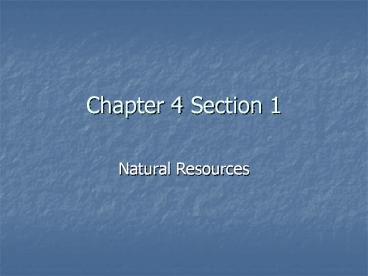Chapter 4 Section 1 - PowerPoint PPT Presentation
1 / 17
Title:
Chapter 4 Section 1
Description:
Chapter 4 Section 1 Natural Resources EARTH S RESOURCES Earth s resources can be classified as renewable or nonrenewable. Resources can be conserved by reducing ... – PowerPoint PPT presentation
Number of Views:150
Avg rating:3.0/5.0
Title: Chapter 4 Section 1
1
Chapter 4 Section 1
- Natural Resources
2
EARTHS RESOURCES
- Earths resources can be classified as renewable
or nonrenewable. - Resources can be conserved by reducing the amount
of resources we use and by reusing or recycling
them. - Earth provides everything needed for life except
energy from the sun.
3
EARTHS RESOURCES cont.
- Earths atmosphere provides the air you breathe,
maintains air temperatures, and produces rain. - The oceans and other waters of Earth give you
food and water. - Earths soil gives nutrients, such as iron, to
the plants you eat.
4
EARTHS RESOURCES cont.
- These resources from Earth are called natural
resources. - A natural resource is any natural material that
is used by humans. - Examples of natural resources are air, soil,
fresh water, petroleum, rocks, minerals, forests,
and wildlife. - Most resources are used in products that make
peoples lives easier and more comfortable.
5
EARTHS RESOURCES cont.
- The energy we get from resources such as gasoline
and wind ultimately comes from the sun. - Some natural resources can be replaced in a
relatively short time. - A renewable resource is a natural resource that
can be replaced at the same rate at which the
resource is used. - Trees and fresh water are two renewable resources.
6
(No Transcript)
7
EARTHS RESOURCES cont.
- If renewable resources are used too quickly, they
can become nonrenewable. - For example, trees are renewable.
- But some forests are being cut down faster than
new forests can grow to replace them.
8
EARTHS RESOURCES cont.
- A nonrenewable resource is a resource that forms
at a much slower rate than the rate at which it
is used. - These resources may take thousands of years to
form. - Coal is a nonrenewable resource that takes many
years to form
9
EARTHS RESOURCES cont.
- Once coal is used up, it is no longer available.
- Petroleum and natural gas are other examples of
nonrenewable resources. - When these resources become scarce, humans will
have to find other resources to use instead.
10
EARTHS RESOURCES cont.
- Whether the natural resources you use are
renewable or nonrenewable, you should be careful
how you use them. - To conserve natural resources, you should try to
use them only when necessary. - For example, running the water only to rinse your
toothbrush when you brush your teeth saves water.
11
CONSERVING NATURAL RESOURCES
- Conserving resources also means taking care of
the resources even when you are not using them. - For example, it is important to keep lakes,
rivers, and other water resources free of
pollution. - Polluted lakes and rivers can affect the water
you drink.
12
CONSERVING NATURAL RESOURCEScont.
- Also, polluted water resources can harm the
plants and animals, including humans, that depend
on them to survive. - The energy we use to heat our homes, drive our
cars, and run our computers comes from natural
resources. - The ways in which we choose to use energy every
day affect the availability of natural resources.
13
CONSERVING NATURAL RESOURCEScont.
- Most of the natural resources that provide us
with energy are nonrenewable resources. - If we dont limit our use of energy now, the
resources may not be available in the future. - As with all natural resources, conserving energy
is important.
14
CONSERVING NATURAL RESOURCEScont.
- You can conserve energy by being careful to use
only the resources that you need. - For example, turn lights off when you are not
using them. - Make sure the washing machine is full before you
start it.
15
CONSERVING NATURAL RESOURCEScont.
- You can also ride a bike, walk, or take a bus
because these methods use fewer resources than a
car does. - Another way to conserve natural resources is to
recycle. - Recycling is the process of recovering materials
from waste or scrap.
16
CONSERVING NATURAL RESOURCEScont.
- Recycling reduces the amount of materials that
must be obtained from Earth. - Recycling paper reduces the number of trees that
must be cut down to make new paper. - Recycling also conserves energy.
- Energy is needed to recycle materials. However,
less energy is needed to recycle an aluminum can
than is needed to make a new one.
17
- Newspaper, glass, aluminum cans, some plastic
packaging, and cardboard boxes can be recycled. - Most plastic containers have a number on them.
- This number informs you what kind of plastic
makes up the container. - Plastic products with the numbers 1 and 2 can be
recycled in most places. - Check with a nearby recycling center to see what
kinds of materials the center recycles.































